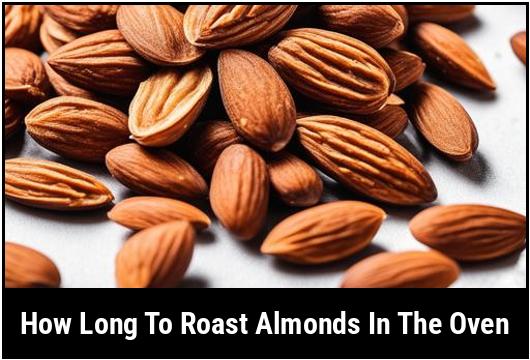[GUIDE] How Long To Roast Almonds In The Oven

Roasted almonds are a delicious and nutritious snack that can be enjoyed on their own or added to various dishes. Whether you want to elevate the flavor of your salads, desserts, or simply want to enjoy a crunchy treat, roasting almonds in the oven is a straightforward process that yields fantastic results. However, it’s crucial to get the timing right to achieve the perfect balance of texture and flavor. In this article, we will explore the ideal cooking time and temperature for roasting almonds in the oven, along with tips, techniques, and troubleshooting advice to ensure your almonds turn out perfectly every time.
Quick Answer: How Long To Roast Almonds In The Oven
Cooking Temperature: 325°F (163°C)
Cooking Time: 10-15 minutes
Key Takeaways
- Roasting almonds enhances their flavor and gives them a satisfying crunch.
- It’s essential to choose high-quality almonds for the best results.
- Preparing the almonds by blanching and drying them beforehand can improve the roasting process.
- Roasting almonds at a temperature of 325°F (163°C) for 10-15 minutes is generally recommended for optimal results.
- Techniques like stirring the almonds midway and using a timer to monitor the cooking time are helpful to ensure even roasting.
- Roasted almonds can be seasoned with various spices and flavors for added versatility.
- When things go wrong, over-roasted or burnt almonds can be salvaged by grinding them into almond butter or using them as toppings for desserts.
The Science Of Cooking Almonds

Roasting almonds in the oven changes their texture, flavor, and color, enhancing their overall appeal. Heating almonds causes several chemical reactions to occur, which contribute to the delicious roasted taste we all love.
When almonds are roasted, the heat causes the natural oils within the nuts to be released, intensifying their nutty aroma and flavor. This process also alters the texture of the almonds, making them crispy on the outside while retaining a slightly chewy interior. The high heat also triggers the Maillard reaction, a chemical process that gives roasted almonds their characteristic golden-brown color.
Choosing Almonds
The quality and freshness of the almonds you choose for roasting can significantly impact the final result. Here are a few tips for selecting the best almonds:
-
Look for whole, unbroken almonds: Ensure that the almonds you purchase are intact and don’t have any cracks or splits.
-
Opt for raw almonds: Raw almonds are a great choice for roasting, as they have a neutral flavor that allows other seasonings to shine. Avoid using pre-roasted or already flavored almonds.
-
Check the expiration date: Almonds, like any other nuts, have a limited shelf life. Before purchasing, check the expiration date and choose almonds that have been recently harvested.
Preparing Almonds
While you can roast almonds directly in the oven, taking a few extra steps to prepare them beforehand can yield better results. Here’s how to prepare almonds for roasting:
-
Blanching: Blanching the almonds involves briefly immersing them in boiling water and then transferring them to a bowl of ice water. This process helps in removing the almond skins easily, resulting in a smoother texture and more even roasting.
Pro Tip: To blanch almonds, boil water in a saucepan and add the almonds. Cook for 1-2 minutes, then drain and transfer the almonds to a bowl of ice water. After a few minutes, drain the almonds and pat them dry.
-
Drying: Remove excess moisture from the blanched almonds by spreading them on a clean kitchen towel or paper towels. Allow the almonds to air-dry for about 10-15 minutes until they are completely dry.
Pro Tip: Drying the almonds before roasting helps in achieving a crispier texture and prevents them from becoming soggy during cooking.
Ideal Cooking Temperature For Almonds
Roasting almonds at the right temperature is crucial to achieve the desired texture and flavor. A moderate oven temperature of 325°F (163°C) is generally recommended for roasting almonds.
At this temperature, the almonds will cook evenly, ensuring a golden-brown color and a crunchy texture. Higher temperatures may cause almonds to burn quickly on the outside while remaining undercooked inside, while lower temperatures may result in longer cooking times and less evenly roasted almonds.
Almonds Cooking Time

The cooking time for roasting almonds primarily depends on the desired level of roast and the amount of moisture in the almonds. As a general guideline, the average cooking time for roasting almonds in a 325°F (163°C) oven is around 10-15 minutes.
However, it’s essential to note that cooking times can vary depending on factors such as the size of the almonds, the moisture content, and your personal preference for the level of roast. To achieve consistent results, it’s best to start with the recommended cooking time and make adjustments based on the outcome.
Cooking Techniques
To ensure even roasting and to prevent burnt spots, proper technique is key. Here are a few techniques to follow when roasting almonds in the oven:
-
Stirring: Midway through the cooking process, gently stir the almonds to promote even browning. This helps prevent any hot spots in the oven and ensures that all the almonds are roasted uniformly.
-
Using a timer: Set a timer to avoid under or overcooking the almonds. Based on your desired level of roast and the recommended cooking time, it’s important to monitor the almonds as they cook to achieve the perfect crunch.
-
Spacing: Spread the almonds in a single layer on a baking sheet to allow for even air circulation. Crowding the almonds may result in uneven cooking, causing some to be undercooked while others become overly roasted.
Monitoring And Troubleshooting
While roasting almonds is a relatively simple process, it’s crucial to monitor them closely to prevent burning. Here are a few tips for monitoring and troubleshooting:
-
Keep an eye on the color: Watch the almonds closely as they roast and look for a golden-brown color. If they appear too dark or are browning too quickly, reduce the oven temperature slightly.
-
Check for doneness: To ensure the almonds are cooked to your desired level of roast, take one almond out of the oven and allow it to cool for a few seconds. Taste and assess the texture. If it’s not to your liking, you can return the tray to the oven for a few more minutes.
-
Adjust cooking time if needed: If the almonds are not roasted to your desired level after the recommended cooking time, you can continue roasting them in 1-2 minute increments until you achieve the perfect crunch and color.
Almonds Cooking Instructions
Now that we have covered the important aspects of roasting almonds, let’s walk through a step-by-step guide on how to roast them in the oven:
-
Preheat your oven: Preheat your oven to 325°F (163°C). This ensures that the almonds roast evenly and remain crisp without burning.
-
Prepare the almonds: If you haven’t already blanched and dried the almonds, follow the steps mentioned in the "Preparing Almonds" section. Ensure that the almonds are completely dry before proceeding.
-
Spread the almonds: Arrange the almonds in a single layer on a baking sheet lined with parchment paper or a silicone baking mat. Make sure they are spaced evenly for even cooking.
Pro Tip: Using a baking sheet with edges helps in preventing the almonds from rolling off the tray while stirring.
-
Place the tray in the oven: Put the baking sheet with the almonds in the preheated oven. For an even roast, position the tray in the center rack.
-
Roast the almonds: Set a timer for 10-15 minutes and allow the almonds to roast. After 5-7 minutes, remove the baking sheet from the oven and gently stir the almonds to ensure even browning. Return the tray to the oven and continue roasting until the almonds turn golden-brown.
-
Test for doneness: Remove one almond from the tray and let it cool for a few seconds. Taste and assess the texture to determine if it has reached your desired level of roast. If not, return the tray to the oven for a few more minutes.
-
Cool and store: Once the almonds are roasted to perfection, remove the baking sheet from the oven and allow the almonds to cool completely on the tray. Transfer the cooled almonds to an airtight container or ziplock bag for storage.
Variations

While roasted almonds are delicious on their own, you can experiment with various flavor combinations and seasonings to add variety to your snack or dishes. Here are a few flavorful variations:
-
Sweet and Spicy Almonds: Toss roasted almonds with a mixture of honey, cinnamon, and cayenne pepper for a sweet and spicy kick.
-
Rosemary and Sea Salt Almonds: Sprinkle freshly roasted almonds with dried rosemary and a pinch of sea salt for a fragrant and savory twist.
-
Smoky Paprika Almonds: Add a smoky and vibrant flavor by coating the almonds with smoked paprika, garlic powder, and a touch of olive oil before roasting.
-
Cocoa and Coconut Almonds: Combine cocoa powder, shredded coconut, and a bit of powdered sugar with roasted almonds for a decadent and indulgent treat.
Feel free to experiment with different spices and flavors to create your own unique roasted almond combinations.
When Things Go Wrong
Sometimes, despite our best efforts, things can go awry during the roasting process. If you accidentally over-roast or burn your almonds, don’t despair. Here are a couple of ways to salvage them:
-
Make almond butter: Grind the over-roasted or burnt almonds in a food processor until they turn into a creamy almond butter. This can be used as a spread, added to smoothies, or incorporated into baked goods.
-
Use as toppings: Crush the over-roasted or burnt almonds and use them as toppings for ice cream, yogurt, or desserts like brownies and cakes. The smoky flavor and crunchy texture can add an interesting element to your treats.
Serving Almonds
Roasted almonds can be enjoyed in various ways, depending on your preferences and the dish you wish to enhance. Here are a few serving ideas:
-
Snack on them: Serve roasted almonds in a bowl as a nutritious and satisfying snack.
-
Salad topping: Sprinkle roasted almonds over salads to add crunch and depth of flavor.
-
Trail mix: Combine roasted almonds with dried fruits, seeds, and other nuts to create a homemade trail mix.
-
Dessert ingredient: Use roasted almonds in your favorite dessert recipes, such as cookies, brownies, and cakes, to provide a delightful texture and nutty taste.
Best Practices For Almonds Cooking
To ensure consistently great results when roasting almonds, consider the following best practices:
-
Use a timer: Set a timer to avoid under or overcooking the almonds. Regularly check on them during the cooking process until you become familiar with the timing and desired level of roast.
-
Stir the almonds: Gently stir the almonds midway through the cooking process to promote even browning and prevent any hot spots.
-
Use a baking sheet with edges: A baking sheet with edges helps in preventing the almonds from rolling off while stirring and ensures that they roast evenly.
-
Store properly: After roasting, store the almonds in an airtight container or ziplock bag to maintain their freshness and crunchiness.
-
Experiment with flavors: Don’t be afraid to try different seasonings and spices to create customized roasted almond variations.
Conclusion
Roasting almonds in the oven is a simple and rewarding process that elevates their flavor and texture, making them a delightful snack or ingredient in various dishes. By following the recommended cooking temperature, time, and techniques, you can achieve perfectly roasted almonds with a golden-brown color and satisfying crunch. Remember to carefully monitor and adjust the cooking time as needed to achieve your preferred level of roast. Whether you enjoy them on their own, as a topping, or as part of a recipe, roasted almonds are sure to impress with their delicious taste and versatility.
FAQS
What Temperature Should The Oven Be Set At To Roast Almonds?
The oven should be preheated to 350°F or 177°C.
How Long Should I Roast Almonds In The Oven For?
Roast almonds in the oven for around 10-15 minutes or until they turn golden brown and you can smell their aroma.
Can I Roast Almonds Without Adding Any Oil?
Yes, you can roast almonds without any added oil. This method is known as dry roasting. However, adding a little oil will help the almonds to roast evenly and prevent them from drying out.
Should I Use Salt When Roasting Almonds?
Yes, you can use salt to add flavor to the roasted almonds. You can also add other spices such as cinnamon, paprika, or cumin to customize the flavor.
How Should I Store The Roasted Almonds?
Allow the almonds to cool completely before storing them in an airtight container at room temperature or in the fridge. They will stay fresh for up to two weeks at room temperature and up to one month in the fridge.
Sources
About the Author Jenny
I'm Jenny, a housewife with an unwavering passion for food. My culinary journey began with my grandmother's kitchen, and it's now a full-fledged food blog. I've turned my love for cooking into a creative outlet, sharing recipes and stories with a global community of fellow food enthusiasts. It's proof that being a housewife can also mean pursuing your passions and savoring life's delectable moments.
